Asia-Pacific Formaldehyde Market Size
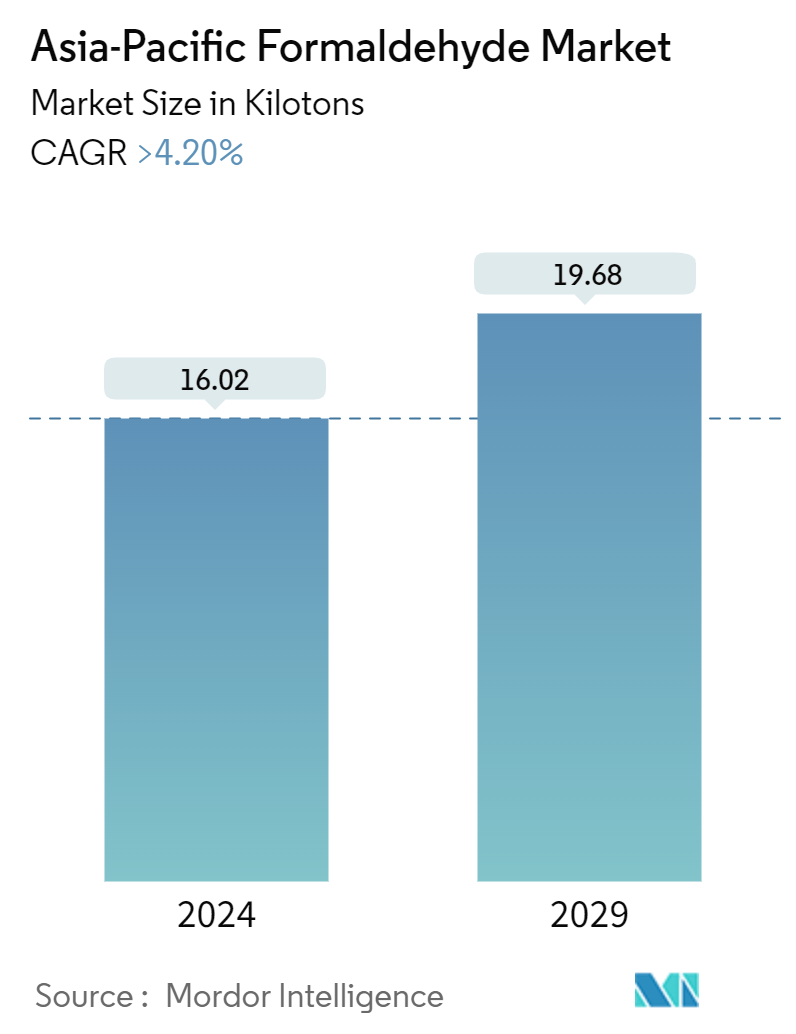
| Study Period | 2019 - 2029 |
| Base Year For Estimation | 2023 |
| Market Volume (2024) | 16.02 Million tons |
| Market Volume (2029) | 19.68 Million tons |
| CAGR (2024 - 2029) | > 4.20 % |
| Market Concentration | Low |
Major Players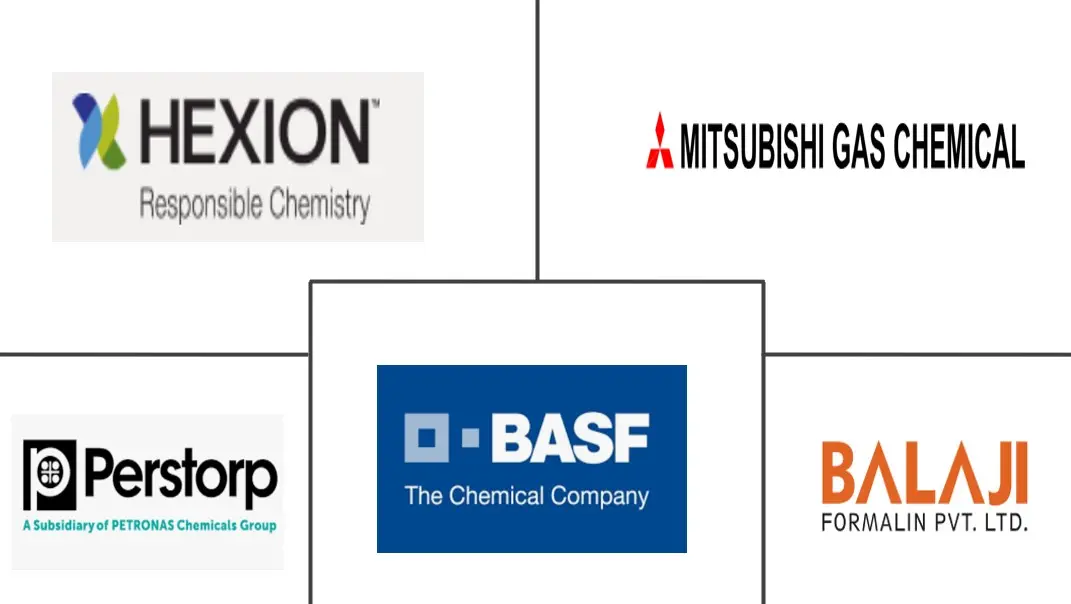
*Disclaimer: Major Players sorted in no particular order |
Asia-Pacific Formaldehyde Market Analysis
The Asia-Pacific Formaldehyde Market size is estimated at 16.02 kilotons in 2024, and is expected to reach 19.68 kilotons by 2029, growing at a CAGR of greater than 4.20% during the forecast period (2024-2029).
In 2020, the Asia-Pacific formaldehyde market faced setbacks due to the COVID-19 pandemic. Labor shortages led to temporary suspensions in key industries like construction and automotive, curtailing formaldehyde consumption. However, post-restrictions, the market rebounded robustly, driven by surging demand from the construction, automotive, and healthcare industries.
• Over the short term, growing demand from the construction industry and increasing usage in the automotive industry are expected to be the major factors driving the demand for the market studied.
• However, the toxic and carcinogenic nature of formaldehyde and stringent regulations amid growing environmental concerns are expected to hinder the market's growth.
• R&D on using formaldehyde for waste treatment is expected to create new opportunities for the market studied.
• China is expected to dominate the formaldehyde market in Asia-Pacific, and it is anticipated to witness the highest growth during the forecast period.
Asia-Pacific Formaldehyde Market Trends
The Construction Industry is Expected to Dominate the Market during the Forecast Period
- The construction industry leads in formaldehyde consumption, primarily for construction, remodeling, and furniture production.
- Formaldehyde-based resins are integral in crafting composite and engineered wood products. These products are used in various applications, including moldings, furniture, countertops, cabinetry, shelving, stairs, wall sheathing, support beams, flooring, trusses, and numerous other household furnishings and structures.
- Asia-Pacific, spearheaded by countries like China, India, and Japan, holds a significant share of the construction segment, thus boosting the demand for domestic formaldehyde.
- In 2023, the construction of new homes in China was reduced owing to the demand for properties. As per the data from statistics released by the National Bureau of Statistics, about 693 million square meters of new homes started construction in 2023, registering a 21% decrease compared to the previous year.
- Similarly, Japan's Ministry of Land Infrastructure, Transport and Tourism (MLIT) reported 819.62 thousand new construction houses in 2023, down by 26% from 859.53 thousand in 2022.
- With the weak demand for various construction properties in the region, the demand for formaldehyde may negatively impact the construction industry.
- However, India is poised to claim the title of the world's third-largest construction market. Driven by initiatives like the Smart Cities project and Housing for All, the Indian government is propelling the construction industry forward. The government has been actively boosting housing construction to provide housing for its vast population of 1.3 billion.
- In the FY 2024 budget, the finance minister pledged support for an additional 20 million houses over the next five years under the Pradhan Mantri Awas Yojana (PMAY).
- Given the robust growth of the Asia-Pacific construction industry, the demand for formaldehyde is poised to rise during the forecast period.
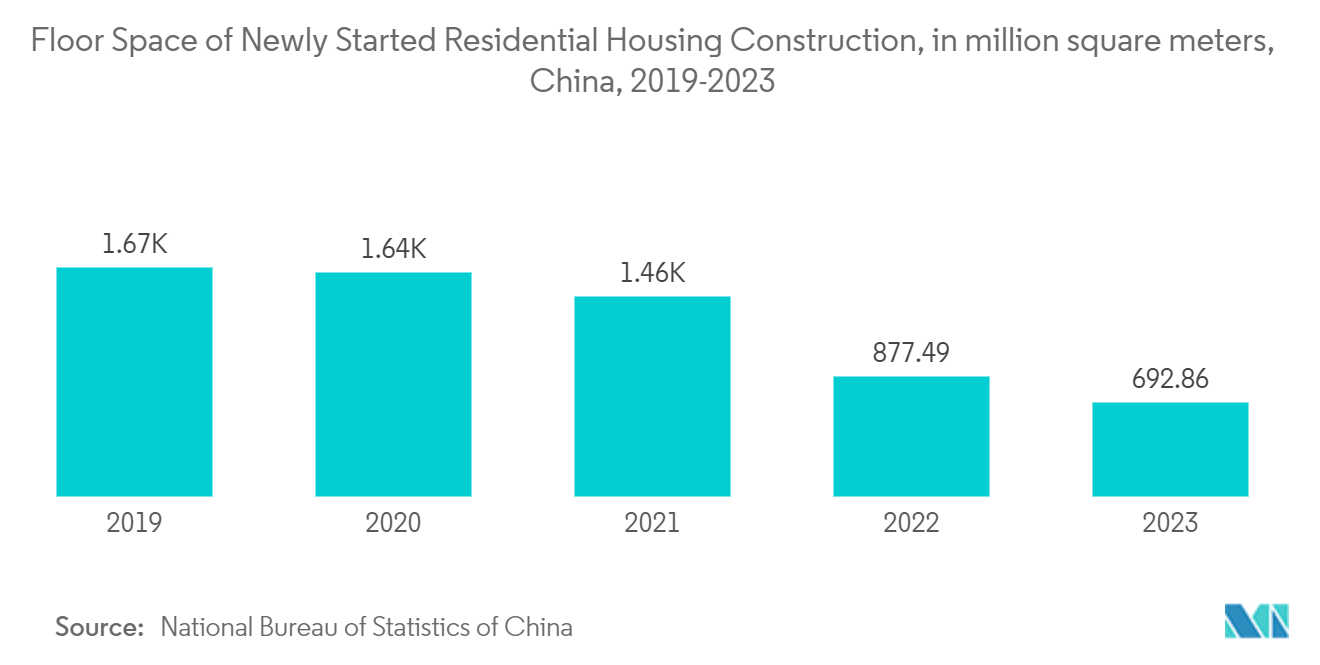
China is Expected to Dominate the Market during the Forecast Period
- China dominated the Asia-Pacific formaldehyde market, with a substantial market and revenue share, and this dominance is expected to continue during the forecast period. Factors such as good adhesive strength and moisture resistance properties of formaldehyde-based resins and continuous demand from the furniture industry are anticipated to drive market growth.
- As per data from the China Association of Automobile Manufacturers (CAAM), China is the world's largest automotive production hub. In 2023, China produced over 30.16 million cars, marking an 11.6% rise from the previous year. Sales figures mirrored this growth, with 30.09 million passenger cars sold, a 12% increase Y-o-Y, according to CAAM data. This trend is expected to support the market studied.
- The Chinese government estimates a 20% penetration rate of electric vehicle production by 2025. Such significant investments are projected to propel the country's automotive industry and positively impact the market studied.
- As per the International Trade Organization, China holds the title of the world's largest construction market. Data from the American Institute of Architects (AIA) Shanghai paints a staggering picture: by 2025, China is expected to erect a cityscape equivalent to 10 New York cities. Despite the recent underperformance, notably in 2023, where China's new residential construction floor space dipped below 700 million square meters, marking the fourth consecutive annual decline from its 2019 peak, the nation's construction industry remains robust, fueled by ongoing urban development initiatives.
- Given these dynamics, the Chinese formaldehyde market is poised for growth in the coming years.
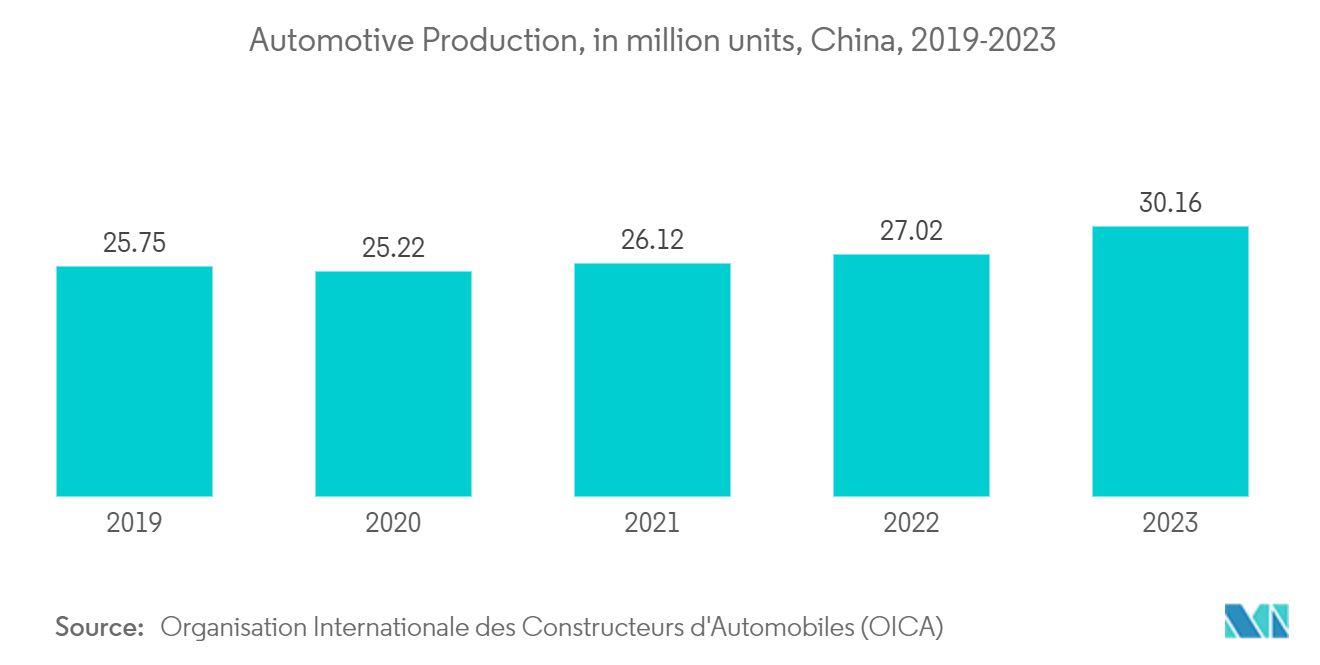
Asia-Pacific Formaldehyde Industry Overview
The Asia-Pacific formaldehyde market is fragmented in nature. The major players (not in any particular order) include BASF SE, Hexion Inc., Perstorp, Mitsubishi Gas Chemical Company, Inc., and Balaji Formalin Private Limited.
Asia-Pacific Formaldehyde Market Leaders
-
BASF SE
-
Hexion
-
Balaji Formalin Private Limited
-
Perstorp
-
Mitsubishi Gas Chemical Company, Inc.
*Disclaimer: Major Players sorted in no particular order
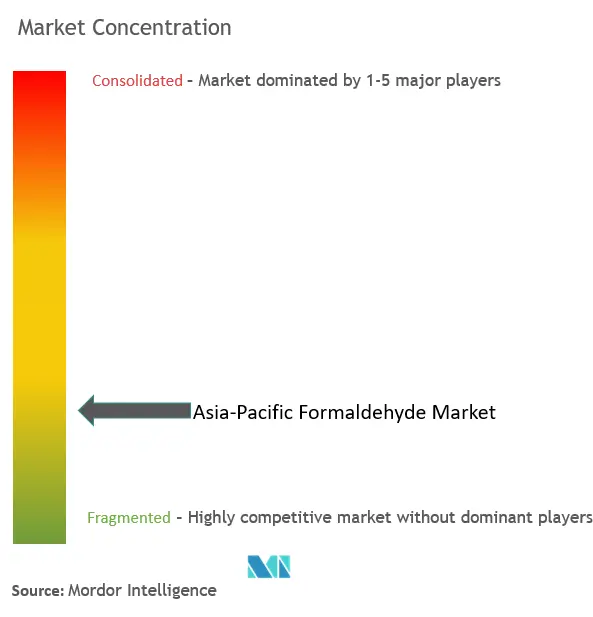
Asia-Pacific Formaldehyde Market News
- April 2023: Kanoria Chemicals & Industries Limited (KCI) was set to boost its formaldehyde production in Ankleshwar, Gujarat, by an additional 300 MTPD, addressing the rising demand in the western region. The expansion is slated for completion in FY 2025. The new formaldehyde facility is expected to utilize cutting-edge metal oxide-based technology. This enhanced capacity, leveraging advanced technology, aims to meet the surging demand across diverse industries, including engineering wood, textiles, agrochemicals, and pharmaceuticals.
- October 2022: Balaji Formalin Private Limited issued an article stating that the company would expand its formaldehyde capacity from 24,000 metric tons per annum to 120,000 metric tons per annum. This expansion is expected to support the company in increasing its regional presence.
- July 2022: A K Formaline Private Limited proposed the environmental clearance for the expansion of formaldehyde manufacturing from 900 metric tons per month to 3,000 metric tons per month in the existing location of Nani Chira, Kutch, Gujarat (India).
Asia-Pacific Formaldehyde Market Report - Table of Contents
1. INTRODUCTION
1.1 Study Assumptions
1.2 Scope of the Study
2. RESEARCH METHODOLOGY
3. EXECUTIVE SUMMARY
4. MARKET DYNAMICS
4.1 Market Drivers
4.1.1 Growing Demand from the Construction Industry
4.1.2 Increasing Usage in the Automotive Industry
4.1.3 Other Drivers
4.2 Market Restraints
4.2.1 Toxic and Carcinogenic Nature of Formaldehyde
4.2.2 Stringent Regulations Amid Growing Environmental Concerns
4.2.3 Other Restraints
4.3 Industry Value-chain Analysis
4.4 Porter's Five Forces Analysis
4.4.1 Bargaining Power of Suppliers
4.4.2 Bargaining Power of Buyers
4.4.3 Threat of New Entrants
4.4.4 Threat of Substitute Products and Services
4.4.5 Degree of Competition
5. MARKET SEGMENTATION (Market Size by Volume)
5.1 Derivative
5.1.1 Urea Formaldehyde
5.1.2 Phenol Formaldehyde
5.1.3 Melamine Formaldehyde
5.1.4 Hexamine
5.1.5 Polyoxymethylene
5.1.6 Other Derivatives (Methylene Diphenyl Diisocyanate and Butanediol)
5.2 End-user Industry
5.2.1 Automotive
5.2.2 Construction
5.2.3 Agriculture
5.2.4 Healthcare
5.2.5 Chemical and Petrochemical
5.2.6 Other End-user Industries (Paints and Textiles)
5.3 Geography
5.3.1 China
5.3.2 India
5.3.3 Japan
5.3.4 South Korea
5.3.5 Malaysia
5.3.6 Thailand
5.3.7 Indonesia
5.3.8 Vietnam
5.3.9 Rest of Asia-Pacific
6. COMPETITIVE LANDSCAPE
6.1 Mergers and Acquisitions, Joint Ventures, Collaborations, and Agreements
6.2 Market Share (%)**/ Ranking Analysis
6.3 Strategies Adopted by Leading Players
6.4 Company Profiles
6.4.1 ARCL Organics Ltd
6.4.2 Asta Chemicals
6.4.3 Bakelite Synthetics
6.4.4 Balaji Formalin Private Limited
6.4.5 BASF SE
6.4.6 Hexion
6.4.7 Hexza Corporation Berhad
6.4.8 Kanoria Chemicals & Industries Ltd (KCI)
6.4.9 Mitsubishi Gas Chemical Company Inc.
6.4.10 Perstorp
6.4.11 Simalin Chemical Industries Pvt. Ltd
6.4.12 Vechem Organics (P) Limited
- *List Not Exhaustive
7. MARKET OPPORTUNITIES AND FUTURE TRENDS
7.1 Research and Development on the Use of Formaldehyde for the Treatment of Waste
7.2 Other Opportunities
Asia-Pacific Formaldehyde Industry Segmentation
Formaldehyde, a colorless and highly reactive gas with a pungent odor, is produced through the catalytic oxidation of methanol. This flammable gas is a crucial precursor for various materials and chemical compounds. Its versatile and advantageous properties have led to its widespread use across numerous applications.
The Asia-Pacific formaldehyde market is segmented by derivative, end-user industry, and geography. By derivative, the market is segmented into urea formaldehyde, phenol formaldehyde, melamine formaldehyde, hexamine, polyoxymethylene, and other derivatives (methylene diphenyl diisocyanate and butanediol). By end-user industry, the market is segmented into automotive, construction, agriculture, healthcare, chemical and petrochemical, and other end-user industries (paints and textiles). The report also covers the market size and forecasts for the formaldehyde market in eight major countries across Asia-Pacific. For each segment, the market sizing and forecasts have been done on the basis of volume (kilo tons).
| Derivative | |
| Urea Formaldehyde | |
| Phenol Formaldehyde | |
| Melamine Formaldehyde | |
| Hexamine | |
| Polyoxymethylene | |
| Other Derivatives (Methylene Diphenyl Diisocyanate and Butanediol) |
| End-user Industry | |
| Automotive | |
| Construction | |
| Agriculture | |
| Healthcare | |
| Chemical and Petrochemical | |
| Other End-user Industries (Paints and Textiles) |
| Geography | |
| China | |
| India | |
| Japan | |
| South Korea | |
| Malaysia | |
| Thailand | |
| Indonesia | |
| Vietnam | |
| Rest of Asia-Pacific |
Asia-Pacific Formaldehyde Market Research Faqs
How big is the Asia-Pacific Formaldehyde Market?
The Asia-Pacific Formaldehyde Market size is expected to reach 16.02 million tons in 2024 and grow at a CAGR of greater than 4.20% to reach 19.68 million tons by 2029.
What is the current Asia-Pacific Formaldehyde Market size?
In 2024, the Asia-Pacific Formaldehyde Market size is expected to reach 16.02 million tons.
Who are the key players in Asia-Pacific Formaldehyde Market?
BASF SE, Hexion, Balaji Formalin Private Limited, Perstorp and Mitsubishi Gas Chemical Company, Inc. are the major companies operating in the Asia-Pacific Formaldehyde Market.
What years does this Asia-Pacific Formaldehyde Market cover, and what was the market size in 2023?
In 2023, the Asia-Pacific Formaldehyde Market size was estimated at 15.35 million tons. The report covers the Asia-Pacific Formaldehyde Market historical market size for years: 2019, 2020, 2021, 2022 and 2023. The report also forecasts the Asia-Pacific Formaldehyde Market size for years: 2024, 2025, 2026, 2027, 2028 and 2029.
Asia-Pacific Formaldehyde Industry Report
Statistics for the 2024 Asia-Pacific Formaldehyde market share, size and revenue growth rate, created by Mordor Intelligence™ Industry Reports. Asia-Pacific Formaldehyde analysis includes a market forecast outlook to 2029 and historical overview. Get a sample of this industry analysis as a free report PDF download.



